+ Open data
Open data
- Basic information
Basic information
| Entry | Database: PDB / ID: 6n4b | |||||||||
|---|---|---|---|---|---|---|---|---|---|---|
| Title | Cannabinoid Receptor 1-G Protein Complex | |||||||||
 Components Components |
| |||||||||
 Keywords Keywords | SIGNALING PROTEIN / Cannabinoid receptor / GPCR / synthetic cannabinoid / Fubinaca / Gi | |||||||||
| Function / homology |  Function and homology information Function and homology informationcannabinoid signaling pathway / regulation of penile erection / retrograde trans-synaptic signaling by endocannabinoid / cannabinoid receptor activity / negative regulation of mast cell activation / negative regulation of fatty acid beta-oxidation / trans-synaptic signaling by endocannabinoid, modulating synaptic transmission / negative regulation of dopamine secretion / positive regulation of acute inflammatory response to antigenic stimulus / negative regulation of serotonin secretion ...cannabinoid signaling pathway / regulation of penile erection / retrograde trans-synaptic signaling by endocannabinoid / cannabinoid receptor activity / negative regulation of mast cell activation / negative regulation of fatty acid beta-oxidation / trans-synaptic signaling by endocannabinoid, modulating synaptic transmission / negative regulation of dopamine secretion / positive regulation of acute inflammatory response to antigenic stimulus / negative regulation of serotonin secretion / regulation of feeding behavior / regulation of presynaptic cytosolic calcium ion concentration / negative regulation of action potential / Class A/1 (Rhodopsin-like receptors) / positive regulation of blood pressure / positive regulation of fever generation / regulation of metabolic process / axonal fasciculation / regulation of synaptic transmission, GABAergic / G protein-coupled receptor signaling pathway, coupled to cyclic nucleotide second messenger / T cell migration / D2 dopamine receptor binding / Adenylate cyclase inhibitory pathway / maternal process involved in female pregnancy / positive regulation of protein localization to cell cortex / regulation of cAMP-mediated signaling / G protein-coupled serotonin receptor binding / GABA-ergic synapse / cellular response to forskolin / regulation of mitotic spindle organization / regulation of synaptic transmission, glutamatergic / negative regulation of blood pressure / regulation of insulin secretion / adenylate cyclase-inhibiting G protein-coupled receptor signaling pathway / response to nutrient / response to cocaine / Regulation of insulin secretion / response to nicotine / G protein-coupled receptor binding / G protein-coupled receptor activity / G-protein beta/gamma-subunit complex binding / Olfactory Signaling Pathway / adenylate cyclase-modulating G protein-coupled receptor signaling pathway / Activation of the phototransduction cascade / adenylate cyclase-activating G protein-coupled receptor signaling pathway / G beta:gamma signalling through PLC beta / Presynaptic function of Kainate receptors / Thromboxane signalling through TP receptor / G protein-coupled acetylcholine receptor signaling pathway / G-protein activation / Activation of G protein gated Potassium channels / Inhibition of voltage gated Ca2+ channels via Gbeta/gamma subunits / memory / Prostacyclin signalling through prostacyclin receptor / response to peptide hormone / Glucagon signaling in metabolic regulation / G beta:gamma signalling through CDC42 / positive regulation of neuron projection development / G beta:gamma signalling through BTK / ADP signalling through P2Y purinoceptor 12 / Sensory perception of sweet, bitter, and umami (glutamate) taste / Synthesis, secretion, and inactivation of Glucagon-like Peptide-1 (GLP-1) / photoreceptor disc membrane / Glucagon-type ligand receptors / Adrenaline,noradrenaline inhibits insulin secretion / Vasopressin regulates renal water homeostasis via Aquaporins / G alpha (z) signalling events / Glucagon-like Peptide-1 (GLP1) regulates insulin secretion / cellular response to catecholamine stimulus / ADORA2B mediated anti-inflammatory cytokines production / sensory perception of taste / ADP signalling through P2Y purinoceptor 1 / G beta:gamma signalling through PI3Kgamma / adenylate cyclase-activating dopamine receptor signaling pathway / Cooperation of PDCL (PhLP1) and TRiC/CCT in G-protein beta folding / GPER1 signaling / GDP binding / cellular response to prostaglandin E stimulus / Inactivation, recovery and regulation of the phototransduction cascade / G-protein beta-subunit binding / heterotrimeric G-protein complex / G alpha (12/13) signalling events / extracellular vesicle / actin cytoskeleton / signaling receptor complex adaptor activity / Thrombin signalling through proteinase activated receptors (PARs) / GTPase binding / glucose homeostasis / retina development in camera-type eye / presynaptic membrane / Ca2+ pathway / cell cortex / phospholipase C-activating G protein-coupled receptor signaling pathway / midbody / growth cone / G alpha (i) signalling events / fibroblast proliferation / spermatogenesis / G alpha (s) signalling events / Hydrolases; Acting on acid anhydrides; Acting on GTP to facilitate cellular and subcellular movement Similarity search - Function | |||||||||
| Biological species |  Homo sapiens (human) Homo sapiens (human) | |||||||||
| Method | ELECTRON MICROSCOPY / single particle reconstruction / cryo EM / Resolution: 3 Å | |||||||||
 Authors Authors | Krishna Kumar, K. / Shalev-Benami, M. / Hu, H. / Weis, W.I. / Kobilka, B.K. / Skiniotis, G. | |||||||||
| Funding support |  United States, 2items United States, 2items
| |||||||||
 Citation Citation |  Journal: Cell / Year: 2019 Journal: Cell / Year: 2019Title: Structure of a Signaling Cannabinoid Receptor 1-G Protein Complex. Authors: Kaavya Krishna Kumar / Moran Shalev-Benami / Michael J Robertson / Hongli Hu / Samuel D Banister / Scott A Hollingsworth / Naomi R Latorraca / Hideaki E Kato / Daniel Hilger / Shoji Maeda / ...Authors: Kaavya Krishna Kumar / Moran Shalev-Benami / Michael J Robertson / Hongli Hu / Samuel D Banister / Scott A Hollingsworth / Naomi R Latorraca / Hideaki E Kato / Daniel Hilger / Shoji Maeda / William I Weis / David L Farrens / Ron O Dror / Sanjay V Malhotra / Brian K Kobilka / Georgios Skiniotis /  Abstract: Cannabis elicits its mood-enhancing and analgesic effects through the cannabinoid receptor 1 (CB1), a G protein-coupled receptor (GPCR) that signals primarily through the adenylyl cyclase-inhibiting ...Cannabis elicits its mood-enhancing and analgesic effects through the cannabinoid receptor 1 (CB1), a G protein-coupled receptor (GPCR) that signals primarily through the adenylyl cyclase-inhibiting heterotrimeric G protein G. Activation of CB1-G signaling pathways holds potential for treating a number of neurological disorders and is thus crucial to understand the mechanism of G activation by CB1. Here, we present the structure of the CB1-G signaling complex bound to the highly potent agonist MDMB-Fubinaca (FUB), a recently emerged illicit synthetic cannabinoid infused in street drugs that have been associated with numerous overdoses and fatalities. The structure illustrates how FUB stabilizes the receptor in an active state to facilitate nucleotide exchange in G. The results compose the structural framework to explain CB1 activation by different classes of ligands and provide insights into the G protein coupling and selectivity mechanisms adopted by the receptor. | |||||||||
| History |
|
- Structure visualization
Structure visualization
| Movie |
 Movie viewer Movie viewer |
|---|---|
| Structure viewer | Molecule:  Molmil Molmil Jmol/JSmol Jmol/JSmol |
- Downloads & links
Downloads & links
- Download
Download
| PDBx/mmCIF format |  6n4b.cif.gz 6n4b.cif.gz | 216.3 KB | Display |  PDBx/mmCIF format PDBx/mmCIF format |
|---|---|---|---|---|
| PDB format |  pdb6n4b.ent.gz pdb6n4b.ent.gz | 160.3 KB | Display |  PDB format PDB format |
| PDBx/mmJSON format |  6n4b.json.gz 6n4b.json.gz | Tree view |  PDBx/mmJSON format PDBx/mmJSON format | |
| Others |  Other downloads Other downloads |
-Validation report
| Summary document |  6n4b_validation.pdf.gz 6n4b_validation.pdf.gz | 1.1 MB | Display |  wwPDB validaton report wwPDB validaton report |
|---|---|---|---|---|
| Full document |  6n4b_full_validation.pdf.gz 6n4b_full_validation.pdf.gz | 1.1 MB | Display | |
| Data in XML |  6n4b_validation.xml.gz 6n4b_validation.xml.gz | 38.5 KB | Display | |
| Data in CIF |  6n4b_validation.cif.gz 6n4b_validation.cif.gz | 58.5 KB | Display | |
| Arichive directory |  https://data.pdbj.org/pub/pdb/validation_reports/n4/6n4b https://data.pdbj.org/pub/pdb/validation_reports/n4/6n4b ftp://data.pdbj.org/pub/pdb/validation_reports/n4/6n4b ftp://data.pdbj.org/pub/pdb/validation_reports/n4/6n4b | HTTPS FTP |
-Related structure data
| Related structure data |  0339MC M: map data used to model this data C: citing same article ( |
|---|---|
| Similar structure data | |
| EM raw data |  EMPIAR-10288 (Title: Cryo electron microscopy of Cannabinoid Receptor 1-G Protein Complex EMPIAR-10288 (Title: Cryo electron microscopy of Cannabinoid Receptor 1-G Protein ComplexData size: 476.0 Data #1: Cryo electron microscopy movies of CB1-Gi complex [micrographs - multiframe]) |
- Links
Links
- Assembly
Assembly
| Deposited unit | 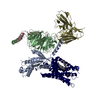
|
|---|---|
| 1 |
|
- Components
Components
-Guanine nucleotide-binding protein ... , 3 types, 3 molecules ABC
| #1: Protein | Mass: 40415.031 Da / Num. of mol.: 1 Source method: isolated from a genetically manipulated source Source: (gene. exp.)  Homo sapiens (human) / Gene: GNAI1 / Production host: Homo sapiens (human) / Gene: GNAI1 / Production host:  Trichoplusia ni (cabbage looper) / References: UniProt: P63096 Trichoplusia ni (cabbage looper) / References: UniProt: P63096 |
|---|---|
| #2: Protein | Mass: 37671.102 Da / Num. of mol.: 1 Source method: isolated from a genetically manipulated source Source: (gene. exp.)  Homo sapiens (human) / Gene: GNB1 / Production host: Homo sapiens (human) / Gene: GNB1 / Production host:  Trichoplusia ni (cabbage looper) / References: UniProt: P62873 Trichoplusia ni (cabbage looper) / References: UniProt: P62873 |
| #3: Protein | Mass: 7861.143 Da / Num. of mol.: 1 Source method: isolated from a genetically manipulated source Source: (gene. exp.)  Homo sapiens (human) / Gene: GNG2 / Production host: Homo sapiens (human) / Gene: GNG2 / Production host:  Trichoplusia ni (cabbage looper) / References: UniProt: P59768 Trichoplusia ni (cabbage looper) / References: UniProt: P59768 |
-Protein / Antibody , 2 types, 2 molecules RS
| #4: Protein | Mass: 55678.535 Da / Num. of mol.: 1 Source method: isolated from a genetically manipulated source Source: (gene. exp.)  Homo sapiens (human) / Gene: CNR1, CNR / Production host: Homo sapiens (human) / Gene: CNR1, CNR / Production host:  |
|---|---|
| #5: Antibody | Mass: 27784.896 Da / Num. of mol.: 1 Source method: isolated from a genetically manipulated source Source: (gene. exp.)   Trichoplusia ni (cabbage looper) Trichoplusia ni (cabbage looper) |
-Non-polymers , 2 types, 3 molecules 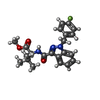


| #6: Chemical | ChemComp-KCA / |
|---|---|
| #7: Chemical |
-Details
| Has protein modification | Y |
|---|
-Experimental details
-Experiment
| Experiment | Method: ELECTRON MICROSCOPY |
|---|---|
| EM experiment | Aggregation state: PARTICLE / 3D reconstruction method: single particle reconstruction |
- Sample preparation
Sample preparation
| Component | Name: Cannabinoid Receptor 1-G Protein Complex / Type: COMPLEX / Entity ID: #1-#5 / Source: RECOMBINANT |
|---|---|
| Molecular weight | Experimental value: NO |
| Source (natural) | Organism:  Homo sapiens (human) Homo sapiens (human) |
| Source (recombinant) | Organism:  Trichoplusia ni (cabbage looper) Trichoplusia ni (cabbage looper) |
| Buffer solution | pH: 7.5 |
| Specimen | Conc.: 5 mg/ml / Embedding applied: NO / Shadowing applied: NO / Staining applied: NO / Vitrification applied: YES |
| Specimen support | Grid material: GOLD / Grid mesh size: 200 divisions/in. / Grid type: Quantifoil R2/2 |
| Vitrification | Instrument: FEI VITROBOT MARK IV / Cryogen name: ETHANE |
- Electron microscopy imaging
Electron microscopy imaging
| Experimental equipment |  Model: Titan Krios / Image courtesy: FEI Company |
|---|---|
| Microscopy | Model: FEI TITAN KRIOS |
| Electron gun | Electron source:  FIELD EMISSION GUN / Accelerating voltage: 300 kV / Illumination mode: FLOOD BEAM FIELD EMISSION GUN / Accelerating voltage: 300 kV / Illumination mode: FLOOD BEAM |
| Electron lens | Mode: BRIGHT FIELD |
| Image recording | Electron dose: 50 e/Å2 / Detector mode: COUNTING / Film or detector model: GATAN K2 SUMMIT (4k x 4k) |
- Processing
Processing
| Software | Name: PHENIX / Version: 1.13_2998: / Classification: refinement | ||||||||||||||||||||||||
|---|---|---|---|---|---|---|---|---|---|---|---|---|---|---|---|---|---|---|---|---|---|---|---|---|---|
| EM software |
| ||||||||||||||||||||||||
| CTF correction | Type: PHASE FLIPPING AND AMPLITUDE CORRECTION | ||||||||||||||||||||||||
| Symmetry | Point symmetry: C1 (asymmetric) | ||||||||||||||||||||||||
| 3D reconstruction | Resolution: 3 Å / Resolution method: FSC 0.143 CUT-OFF / Num. of particles: 177787 / Symmetry type: POINT | ||||||||||||||||||||||||
| Refinement | Highest resolution: 3 Å | ||||||||||||||||||||||||
| Refine LS restraints |
|
 Movie
Movie Controller
Controller



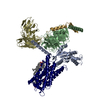

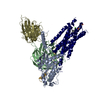
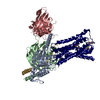
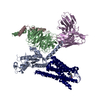


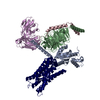
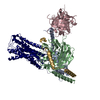
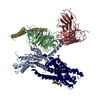
 PDBj
PDBj


































